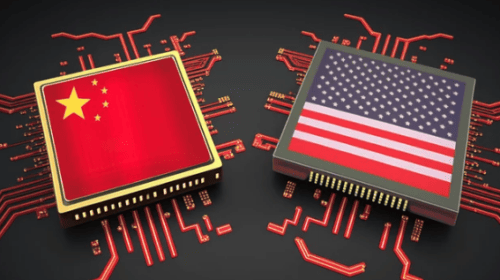Nexperia Auto Chip Crisis: Geopolitical Standoff Disrupts Global Automotive Supply Chain

相关个股
Integrated Analysis
This analysis is based on the CNBC report [1] published on November 1, 2025, detailing the escalating Nexperia auto chip crisis that has triggered emergency geopolitical negotiations.
Crisis Origins and Escalation
The standoff began in September 2025 when the Dutch government invoked Cold War-era legislation to seize control of Nexperia, citing national security concerns over potential intellectual property transfer to China [1]. Beijing retaliated in October 2025 by blocking exports of Nexperia’s finished products from China, effectively disrupting the company’s specialized automotive chip supply chain [1]. The situation intensified in late October when Wingtech Technology, Nexperia’s Chinese owner, was placed on a U.S. blacklist for allegedly aiding China’s acquisition of sensitive semiconductor manufacturing capabilities [1].
Automotive Industry Impact Assessment
The crisis has already moved beyond theoretical concerns to concrete production disruptions. Honda Motor (HMC) became the first major automaker to announce production cuts affecting all main North American plants across the U.S., Canada, and Mexico [2]. The company’s stock closed at $30.50, down 1.83% on November 1, 2025 [0]. Other major automakers including Ford (F), General Motors (GM), Stellantis (STLA), Mercedes-Benz, and Volkswagen (VOW3.DE) have established emergency “war rooms” to manage the crisis on a day-by-day basis [2].
Supply Chain Vulnerability Analysis
Nexperia’s critical role in the automotive supply chain stems from its specialization in high-volume production of foundational semiconductors—transistors, diodes, and power management components essential for basic vehicle functions [1][2]. These components support:
- Battery-to-motor connections in electric vehicles
- Lighting systems and sensors
- Braking systems and airbag controllers
- Entertainment systems and electric windows
The company’s business model involved approximately 70% of chips made in the Netherlands being sent to China for completion and re-export to other countries, creating a single point of failure in the global automotive supply chain [1]. With $2 billion in annual sales, Nexperia’s disruption represents a significant threat to automotive production worldwide.
Market Performance Context
The automotive sector’s concerns are reflected in broader market performance. The Consumer Cyclical sector was down 0.41% on November 1, 2025, while the Technology sector declined 1.74%, potentially influenced by semiconductor supply chain concerns [0]. Major indices showed mixed performance, with the S&P 500 (^GSPC) down 0.50% to 6,840.19 and the Dow Jones (^DJI) down 0.10% to 47,562.88 on October 31, 2025 [0].
Key Insights
Geopolitical Supply Chain Vulnerability
This crisis represents a new paradigm in supply chain disruptions—geopolitical rather than pandemic-driven. Unlike the 2020-2022 chip shortages caused by demand shocks and production constraints, this disruption stems from deliberate government actions targeting technology transfer concerns [2]. The European Automobile Manufacturers’ Association warned that “assembly line stoppages might only be days away” [2], highlighting the immediate threat to automotive production.
Industry Structural Weaknesses
The crisis exposes critical vulnerabilities in modern automotive manufacturing:
- Just-in-Time Manufacturing: Minimal buffer stocks for essential components create immediate production risks when supply is disrupted [2]
- Legacy Semiconductor Dependence: The affected chips are older technology components with insufficient alternative sources according to S&P Global Mobility [2]
- Geographic Concentration: German automakers are particularly sensitive due to heavy reliance on domestic “Tier 1” suppliers and local production facilities [2]
Emerging Resolution Framework
Despite the escalating crisis, there are emerging signs of potential diplomatic resolution. The U.S. plans to announce that Nexperia will resume shipping chips under a framework agreement from Trump-Xi talks, while China indicated it will exempt some Nexperia chips from its export ban [1]. However, the specific types and quantities of exempted chips remain undefined, creating continued uncertainty for automakers [1].
Risks & Opportunities
Immediate Risk Factors
The geopolitical nature of this supply disruption creates significant uncertainty for automotive production forecasts and financial performance through Q4 2025. Key risks include:
- Production Cascade Risk: Following Honda’s production cuts, additional automakers may be forced to announce similar disruptions [2]
- Supply Chain Bottleneck: Limited alternative suppliers for these specialized automotive chips could extend disruptions beyond the immediate diplomatic resolution [2]
- Quarterly Earnings Impact: Automotive company Q4 2025 guidance and results will likely reflect supply chain impacts and production shortfalls
Critical Monitoring Indicators
- Production Announcements: Watch for additional automakers following Honda’s lead in announcing production cuts [2]
- Exemption Clarification: Monitor specific details of China’s export ban exemptions for Nexperia chips [1]
- Alternative Supply Development: Track industry efforts to secure backup sources for legacy semiconductors [2]
- Geopolitical Negotiations: Follow developments in U.S.-China-EU negotiations regarding technology transfer and security oversight [1]
Opportunity Windows
- Supply Chain Diversification: Companies that successfully develop alternative sources for foundational semiconductors may gain competitive advantage
- Domestic Production Incentives: The crisis may accelerate investments in regional semiconductor manufacturing capacity
- Strategic Stockpiling: Automotive companies may reconsider just-in-time inventory models for critical components
Key Information Summary
The Nexperia auto chip crisis represents a significant geopolitical disruption to global automotive production, with immediate impacts already affecting Honda’s North American operations and threatening broader industry production [1][2]. The standoff stems from Dutch national security concerns over Chinese ownership of critical semiconductor manufacturing, triggering retaliatory export controls that have created a single point of failure in the automotive supply chain [1].
While emergency diplomatic efforts are underway and there are signs of potential resolution through framework agreements and export exemptions [1], the crisis exposes fundamental vulnerabilities in automotive supply chain design, particularly the reliance on just-in-time inventory systems and geographic concentration of legacy semiconductor production [2]. The situation warrants close monitoring through Q4 2025 as production impacts materialize and companies work to secure alternative supply sources.
数据基于历史,不代表未来趋势;仅供投资者参考,不构成投资建议
